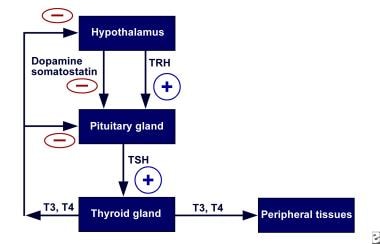Background
To discuss hyperthyroidism, particularly pediatric hyperthyroidism, begin by defining terms. Although “hyperthyroidism” and “thyrotoxicosis” are often used synonymously, these terms actually refer to distinct conditions that should be differentiated.
Hyperthyroidism refers to overactivity of the thyroid gland, which leads to excessive release of thyroid hormones and consequently accelerated metabolism in the peripheral tissues. Thyrotoxicosis, however, refers to the clinical effects of unbound thyroid hormones, whether or not the thyroid gland is the primary source.
Hyperthyroidism is a relatively rare condition in children. The vast majority of cases are caused by Graves disease. Numerous therapeutic options are available, so most patients do well. The risk of relapse or subsequent hypothyroidism is substantially higher in adults than in children and adolescents. In atypical cases, a small number of patients may have hyperthyroidism due to other causes (see Etiology).
The following image depicts the hypothalamic-pituitary-thyroid negative/positive feedback system.
Schematic representation of the negative/positive feedback system with respect to the hypothalamic-pituitary-thyroid axis. TRH = thyrotropin-releasing hormone; TSH = thyroid-stimulating hormone.
See also Pediatric Graves Disease; Hyperthyroidism; Hyperthyroidism, Thyroid Storm, and Graves Disease in Emergency Medicine; Pediatric Hypothyroidism; Graves Disease; Orbital Decompression for Graves Disease; and Thyroid-Associated Orbitopathy.

